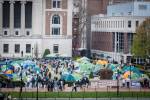Anti-gun politics detrimental to wildlife conservation efforts
As the new year dawns, America’s sportsmen and the wildlife resources we treasure face an uncertain future.
In a few weeks, President-elect Obama will be inaugurated, and he, along with members of his new administration, will take control of the country’s helm. It’s then that campaign rhetoric finally will give way to reality, and we will get the first clear look at what the next four years will hold.
Sportsmen face two primary issues. On one hand is our collective concern for the future of the constitutional right to own the firearms we use for hunting and personal protection. On the other is concern for the future of wildlife and wild places. Public access to those wild places is as much of an issue as protecting them. What most people don’t understand is the vast majority of funding for wildlife and wild places is tied to personal firearms ownership.
Nowhere is that ignorance more apparent than in Congress.
Politicians seeking to appease those meek and timid souls, who prefer to hand control of their life over to some government agency, make continued attempts to gut the Second Amendment. Many of those same politicians have news conferences to talk about wildlife conservation efforts while seemingly unaware they are cutting the purse strings of conservation with their anti-gun politics. Then again, we are talking about politicos and their double-speak, so who knows what they really represent?
The dependence of America’s wildlife conservation efforts on private gun ownership was formalized in 1937 when a wiser Congress than ours today passed the Federal Aid in Wildlife Restoration Act. Commonly referred to as the Pittman-Robertson Act, this law was enacted at the behest of America’s original conservationists — sportsmen who were concerned about the country’s fast-diminishing wildlife and wild places.
The law placed an excise tax on sporting arms and ammunition. Money generated through this tax funds wildlife management on federal and state levels, the purchase and rehabilitation of wildlife habitat, the creation and management of wildlife refuges and the states’ hunter safety programs, among others.
Between 1939 and 2007, nearly $5.3 billion was collected through the Wildlife Restoration program and distributed among the 50 states. More than $93 million came to Nevada. When combined with hunting license dollars, that amount becomes more significant. The extended economic impact of hunting and other related activities is well documented, especially in small rural communities that depend on sportsmen’s dollars for their livelihood.
In another ironic twist, the new administration is basing its economic strategy in large measure on alternative energy, praising its greenness. I wonder if they understand that wind developers favor the West’s high plateaus and scenic mountain passes over the desolate, wind-blown valleys.
Given the broader picture, it would appear some politicians are bent on “cutting off their nose to spite their face,” as my dad is fond of saying. And with Obama’s history of supporting the most outrageous gun control measures, I hope he has a good plastic surgeon.
• Shooting Park construction — If you look through your binoculars toward the north end of the valley, you probably will be able to see where construction of the new Clark County Shooting Park is progressing at the base of the Las Vegas Range.
I had the opportunity to visit the site with Don Turner, manager of the Clark County Shooting Park. He expects the park to be open in middle to late 2009.
Foundations for the four buildings in the public-use area, including the Hunter Education building, were poured last week. The first course of block went down this week, and excavation is under way on foundations for the skeet houses.
The sound test demanded by the Carmel Canyon folks was completed, and results are expected this month. As for the court action in which the homeowners asked for an injunction against the park, it still is open, but no hearing date has been set.
Freelance writer Doug Nielsen is a conservation educator for the Nevada Department of Wildlife. His column is not affiliated with or endorsed by the department. Any opinions he states in his column are his own. He can be reached at doug@takinitoutside.com.


















